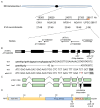Twin Embryos in Arabidopsis thaliana KATANIN 1 Mutants
- PMID: 38999664
- PMCID: PMC11244573
- DOI: 10.3390/plants13131824
Twin Embryos in Arabidopsis thaliana KATANIN 1 Mutants
Abstract
Regulation of microtubule dynamics is crucial during key developmental transitions such as gametogenesis, fertilization, embryogenesis, and seed formation, where cells undergo rapid changes in shape and function. In plants, katanin plays an essential role in microtubule dynamics. This study investigates two seed developmental mutants in Arabidopsis thaliana, named elk5-1D (erecta-like 5, ELK5) and loo1 (lollipop 1), which are characterized by round seeds, dwarfism, and fertility defects. Notably, elk5-1D exhibits a dominant inheritance pattern, whereas loo1 is recessive. Through positional cloning, we identified both mutants as new alleles of the KATANIN 1 (KTN1) gene, which encodes a microtubule-severing enzyme critical for cell division and morphology. Mutations in KTN1 disrupt embryo cell division and lead to the emergence of a twin embryo phenotype. Our findings underscore the essential role of KTN1 in fertility and early embryonic development, potentially influencing the fate of reproductive cells.
Keywords: Arabidopsis thaliana; KATANIN 1; embryogenesis; microtubule; twin embryo.
Conflict of interest statement
The authors declare no conflicts of interest.
Figures








Similar articles
-
KATANIN 1 Is Essential for Embryogenesis and Seed Formation in Arabidopsis.Front Plant Sci. 2017 May 5;8:728. doi: 10.3389/fpls.2017.00728. eCollection 2017. Front Plant Sci. 2017. PMID: 28529520 Free PMC article.
-
Katanin Effects on Dynamics of Cortical Microtubules and Mitotic Arrays in Arabidopsis thaliana Revealed by Advanced Live-Cell Imaging.Front Plant Sci. 2017 May 24;8:866. doi: 10.3389/fpls.2017.00866. eCollection 2017. Front Plant Sci. 2017. PMID: 28596780 Free PMC article.
-
MOR1/MAP215 acts synergistically with katanin to control cell division and anisotropic cell elongation in Arabidopsis.Plant Cell. 2022 Jul 30;34(8):3006-3027. doi: 10.1093/plcell/koac147. Plant Cell. 2022. PMID: 35579372 Free PMC article.
-
Katanin: A Sword Cutting Microtubules for Cellular, Developmental, and Physiological Purposes.Front Plant Sci. 2017 Nov 21;8:1982. doi: 10.3389/fpls.2017.01982. eCollection 2017. Front Plant Sci. 2017. PMID: 29209346 Free PMC article. Review.
-
Models, Regulations, and Functions of Microtubule Severing by Katanin.ISRN Mol Biol. 2012 Sep 27;2012:596289. doi: 10.5402/2012/596289. eCollection 2012. ISRN Mol Biol. 2012. PMID: 27335666 Free PMC article. Review.
References
Grants and funding
LinkOut - more resources
Full Text Sources

